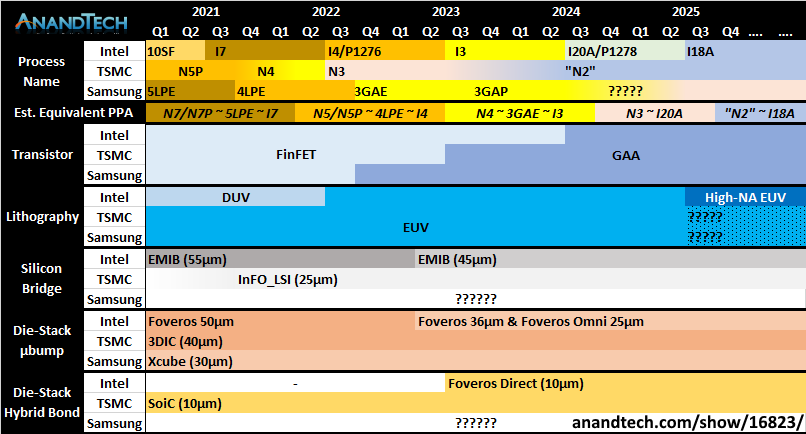Intel's Process Roadmap to 2025: with 4nm, 3nm, 20A and 18A?!
by Dr. Ian Cutress on July 26, 2021 5:00 PM ESTCustomers Customers Customers
As a roadmap announcement today, the focus isn’t so much on the customers but on the technology. Because Intel is moving into a phase where it expects its IFS offerings to compete against the established players, it has to consider its disclosures with respect to both its internal use and any external interest, which is a new concept for the company – at least on this scale compared to its previous foundry efforts.
Intel CEO Pat Gelsinger, in the company’s Q3 financial call last week, was keen to point out that they already have a large hyperscaler customer signed up for their next generation packaging technology, however today there would appear to also be another customer in the mix. Now we assume that Intel’s Foundry Services is talking to 100s of chip companies, big and small, but it doesn’t take much to sign an NDA to start to talk – what will be interesting is when customers start making commitments to using Intel’s facilities, and if any of those are volume orders.
As part of the announcement today, Intel held a little bit back from us, saying that they are saving some of the details specifically for the event that is going on as we publish this piece. All we know is that our draft press release has a big yellow bar that says ‘[customer news]’ on it, right next to Intel’s 20A process node details.
For reference, Intel 20A is a 2024 technology using first generation Gate-All-Around transistors, marketed as RibbonFETs, as well as backside power delivery, marketed as PowerVias. At this time Intel expects to have second/third-generation EMIB available as well as fourth-generation Foveros Direct. So if a customer is already committing to Intel 20A, there’s going to be a lot of potential here.
When the announcement is made, we will update this news article.
To conclude, Intel maintains that these roadmaps will showcase a clear path to process performance leadership* by 2025. It’s a tall order, and the company has to execute better than it has in recent memory - but that’s kind of why the company has rehired a number of former Intel experts and fellows in research, product design, and execution.
*as measured by performance per watt at iso-power
Here's a secondary comparison chart (compared to the one on page one) with all three main foundry offerings listed in each of the main segments that Intel has discussed today.











326 Comments
View All Comments
throAU - Tuesday, July 27, 2021 - link
as an ice lake laptop user it may have been a shipping product, but it’s crap. hot, noisy, outperformed by my 3 year old ipad pro.nico_mach - Tuesday, July 27, 2021 - link
This is the key thing. The article concludes that Intel 10nm=industry's 7nm, but performance of the actual chips (CPUs and also GPUs) are night and day different. It doesn't match up to reality. Which doesn't mean that Intel/article are wrong, but it needs some explaining if the x86 instruction set or Windows/Android/NVIDIA/AMD are the culprits or what. Everyone using Mac laptops through the years knows what the reality is. Same with AMD vs Intel on the desktop in the last couple years.mode_13h - Wednesday, July 28, 2021 - link
> The article concludes that Intel 10nm=industry's 7nmUm, did you read it? Because they didn't *completely* lay this out, but Intel is projected to have 4 full iterations of 10 nm, by the time they move to a higher density. The first was Cannon Lake, Ice Lake was second (10 nm+), Tiger Lake (10 nm SF) is 3rd, and Alder Lake (10 nm ESF - now Intel 7) is to be the 4th. There are significant performance and efficiency changes between each.
Amandtec - Tuesday, July 27, 2021 - link
The wheels fell off because they thought the could continue to shrink without EUV including buying expensive ASML machines that have limited supply and take long from order to delivery. Once they realized their error they were stranded. Note that this is just inferred as a reasonable explanation from what transpired - there is no hard proof of this, so the real cause may be something else.Spunjji - Thursday, July 29, 2021 - link
One thing we can reliably infer is that the solutions involved decreasing density in shipping products and (initially, at least) accepting abysmal yields. For example, even now, they still talk about wafers when they talk about finally producing more 10nm than 14nm... but wafers are input, not output.FreckledTrout - Monday, July 26, 2021 - link
20Å ~= 20 AmpsIntel please change it to 20Å as it looks cooler and isn't as confusing.
regsEx - Monday, July 26, 2021 - link
99% of users in this World have no this letter on their keyboardsAshinjuka - Monday, July 26, 2021 - link
ALT+143 is literally how I typed this: Åikjadoon - Monday, July 26, 2021 - link
Å, well bam, there ya.Amandtec - Tuesday, July 27, 2021 - link
That is four letters so regsEx is right. Still is would be pretty CÖÖL!